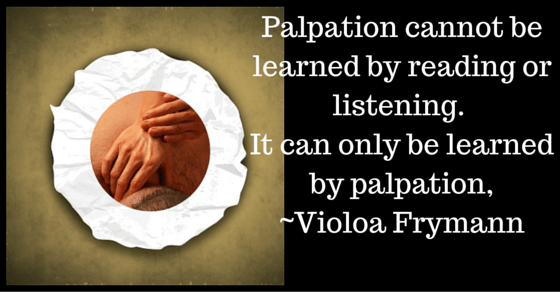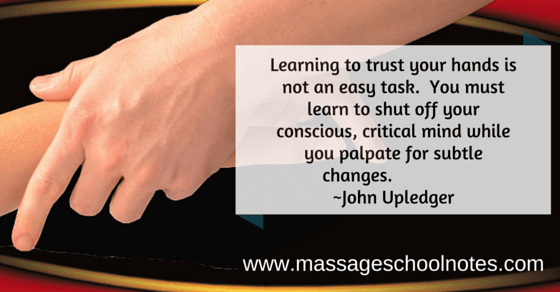
ELAP recommendations:
Why should you learn palpation skills?
What ‘tools’ can you use to palpate?
What are the goals of palpating?
Learn to discriminate levels of tissue, muscle, bone and joints. Sense differences in tissue quality.
Palpation skills for massage therapists is learning to use touch to identify the various soft tissue structures of the body and the condition of those tissues. What you learn from touching is used to assess the somatic responses of the body and for making treatment decisions. Through palpation, soft tissue such as ligaments, muscles, tendons, joint capsules and other body parts can be identified. Palpation of the physical aspects of the body is only the beginning. Once you can feel the physical aspects then you can use what you learn to assist clients in learning to feel their bodies more.
Touch is the only sense where you are also touched when you touch someone else. Learning to touch others with intention and care you will be also able to tune into what you are feeling when you touch. This is one of the keys to working in a therapeutic relationship with a client.
Learning Palpation Skills
Learning to palpate and feel a clients body is a matter of just practicing and figuring out what it is that you are touching. With supervised practice and guidance your skills can constantly improve as you begin to trust your senses. Only you know what you are feeling. The client only knows what they are feeling.
Palpation is done mainly with the hands but some of your other senses may also come into play when working with clients. Sight, smell and hearing may also be used. It is also necessary to have a good understanding of anatomy and physiology so you can begin to understand the structures and what you are feeling under your fingers/hands when you touch.
Begin by recognizing how you use your senses. Palpation is a collection of several abilities. The dominant eye is used to focus on the object while the non-dominant eye provides depth perception. You can find your dominant eye by holding your arm out in front of your eyes and holding up your thumb. Aim it at something in the distance and alternately close one eye at a time. The eye that sees the thumb as aiming at the object is your dominant eye.
Peripheral vision is important in sensing movement.

Different areas of the hand are sensitive to different types of stimuli.
- Pads of the fingers are most sensitive for fine tactile discrimination. You can use them to sense texture, tension, surface resistance, small areas and pulses. The tips of the fingers are not as sensitive and are not large enough to sense the full shape of most structures.
- The back of the hand and fingers are most sensitive to temperature
- The palm of the hand is most sensitive to vibration and shapes. You can switch between the palmar surface of the fingers and the palm.
Use a light touch to keep your senses open and to prevent distorting the tissue being touched. Too much pressure will override the sensitivity of your touch as well as solicit various responses in the client such as guarding and increased tension.
You can adjust the depth, direction and duration of your touch to assess the tissue.
Knowing your underlying anatomy is important here. Find the prominent landmarks and muscles.
You are the only one who can determine how things feel to you.
Keep in touch with your client at all times. Get as much feedback as you can.
- Use client feedback to educate the student about palpation
- use information to educate clients about touch and their bodies
- Ask questions that are open ended (not yes or no questions) Use where, what, why
- The client is always right. Your role is to just provide feedback and mirror what you find.
Ask questions:
What do you feel when I am touching here?
What physical or non-physical sensations do you feel here?
What in your body needs attention?
Can you feel the tension here?
Can you feel the difference now?
Observation is the act of gathering objective signs. A sign is a measurable or observable indication of less than normal function. A sign is not a feeling. You can observe injuries and how the body compensates for those injuries. Look for signs of heat, swelling, cold areas, redness, paleness, contours and tension.
5 Objectives of Palpation
(Mentioned in the book Palpation Skills by Leon Chaitow, as summarized by Philip Greenman in Principles of Manual Medicine)
- Detect abnormal tissue texture
- Evaluate symmetry in the position of the structures, both tactically and visually.
- Detect and assess variations in range and quality of movement during the range, as well as the quality of the end of the range of any movement.
- Sense the position in space of yourself and the person being palpated.
- Detect and evaluate change in the palpated findings, whether these are improving or worsening as time passes.
Also important to note the texture, resilience, warmth, humidity of the skin and tissues.
Resources:
Know your anatomy and physiology.
Know your kinesiology and insertions, origins of muscle attachements